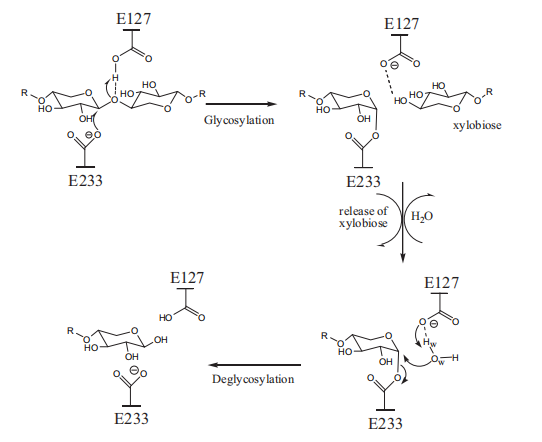

1.Introduction
Xylanases are glycoside hydrolase enzymes that catalyze the hydrolysis of xylan, a major component of hemicellulose in plant cell walls. Xylan is a complex polysaccharide consisting of a β-1,4-linked xylose backbone that can be substituted with various side groups[1, 2]. Xylanases play a crucial role in degrading xylan into smaller xylo-oligosaccharides and xylose, which have important industrial applications[1, 3, 4]. The catalytic mechanism of xylanases involves a double displacement reaction with retention of the anomeric configuration, carried out by two catalytic glutamate residues. Substrate binding and specificity are determined by the active site architecture and specific amino acid residues. Glycosylation and disulfide bridges can modulate the enzymatic properties and thermostability of xylanases. Understanding the catalytic mechanism, substrate specificity, and factors influencing enzyme properties is crucial for optimizing xylanases for various industrial applications.
2.Catalytic Mechanism
Xylanases primarily belong to glycoside hydrolase (GH) families 10 and 11[1, 5]. The catalytic mechanism involves a double displacement reaction that follows a retaining mechanism, conserving the substrate's anomeric configuration[1, 6-8].

Figure 1Proposed catalytic mechanism for the hydrolysis of xylopentaose catalyzed by Xylanase Cex from C. fimi.[9]
i.The reaction occurs in two steps:
a.Glycosylation: A catalytic nucleophile (typically Glu) attacks the anomeric carbon of the scissile glycosidic bond, forming a covalent glycosyl-enzyme intermediate and releasing the leaving group. This is facilitated by a catalytic acid/base residue (usually Glu) that protonates the glycosidic oxygen[1, 6-8, 10].
b.Deglycosylation: A water molecule, activated by the now deprotonated acid/base residue, attacks the anomeric carbon of the glycosyl-enzyme intermediate, cleaving the covalent bond and releasing the product with retention of the original anomeric configuration[1, 6-8, 10].
The two catalytic glutamate residues are optimally positioned in the active site for the double displacement mechanism[1, 6, 8, 10]. Computational studies have provided insights into the detailed reaction mechanism, supporting the formation of a short-lived oxocarbenium ion intermediate during the glycosylation step[6, 10].
ii.Substrate Binding and Specificity
Xylanases have a characteristic (β/α)₈ TIM-barrel fold with the active site located at the C-terminal end of the β-strands[1, 2, 5]. The substrate-binding cleft can accommodate several xylose units, with the number of subsites varying among different xylanases[1, 2, 5].
Substrate specificity is determined by the architecture of the substrate-binding cleft and specific amino acid residues that interact with the xylan backbone and side groups[1, 2, 5]. GH10 xylanases have a more open and flexible active site, allowing them to accommodate substituted xylan, while GH11 xylanases have a narrower and less flexible active site, making them more specific for unsubstituted regions of the xylan backbone[1, 2, 5].
iii.Role of Glycosylation and Disulfide Bridges
N-glycosylation and disulfide bridges can play important roles in modulating the enzymatic properties and thermostability of xylanases[11, 12]. Studies have shown that glycosylation can affect pH adaptation, specific activity, and thermal stability[11, 12]. The degree and site of glycosylation can have diverse effects on enzyme properties[11, 12]. Disulfide bridges have also been found to contribute to the high thermostability of some xylanases[13].
References
1. Liu, J., C. Zhang, and D. Xu, QM/MM study of catalytic mechanism of Xylanase Cex from Cellulomonas fimi. J Mol Graph Model, 2012. 37: p. 67-76.
2. Lafond, M., et al., GH10 xylanase D from Penicillium funiculosum: biochemical studies and xylooligosaccharide production. Microb Cell Fact, 2011. 10: p. 20.
3. Koh, S., et al., Xylanase from Marine Filamentous Fungus Pestalotiopsis sp. AN-7 Was Activated with Diluted Salt Solution Like Brackish Water. J Appl Glycosci (1999), 2021. 68(1): p. 11-18.
4. Ribeiro, L.F., et al., A novel thermostable xylanase GH10 from Malbranchea pulchella expressed in Aspergillus nidulans with potential applications in biotechnology. Biotechnol Biofuels, 2014. 7: p. 115.
5. Xie, W., et al., Insights into the Catalytic Mechanism of a Novel XynA and Structure-Based Engineering for Improving Bifunctional Activities. Biochemistry, 2021. 60(26): p. 2071-2083.
6. Ishida, T., J.M. Parks, and J.C. Smith, Insight into the Catalytic Mechanism of GH11 Xylanase: Computational Analysis of Substrate Distortion Based on a Neutron Structure. J Am Chem Soc, 2020. 142(42): p. 17966-17980.
7. Wan, Q., et al., X-ray crystallographic studies of family 11 xylanase Michaelis and product complexes: implications for the catalytic mechanism. Acta Crystallogr D Biol Crystallogr, 2014. 70(Pt 1): p. 11-23.
8. Wicki, J. Insights into the catalytic mechanism of a retaining xylanase from Cellulomonas fimi. 2007.
9. Liu, J., C. Zhang, and D. Xu, QM/MM study of catalytic mechanism of Xylanase Cex from Cellulomonas fimi. Journal of Molecular Graphics and Modelling, 2012. 37: p. 67-76.
10. Xiao, K. and H. Yu, Rationalising pK(a) shifts in Bacillus circulans xylanase with computational studies. Phys Chem Chem Phys, 2016. 18(44): p. 30305-30312.
11. Chang, X., et al., Role of N-linked glycosylation in the enzymatic properties of a thermophilic GH 10 xylanase from Aspergillus fumigatus expressed in Pichia pastoris. PLoS One, 2017. 12(2): p. e0171111.
12. Fonseca-Maldonado, R., et al., Engineering the pattern of protein glycosylation modulates the thermostability of a GH11 xylanase. J Biol Chem, 2013. 288(35): p. 25522-25534.
13. Tan, Z., et al., Exploration of disulfide bridge and N-glycosylation contributing to high thermostability of a hybrid xylanase. Protein Pept Lett, 2014. 21(7): p. 657-62.